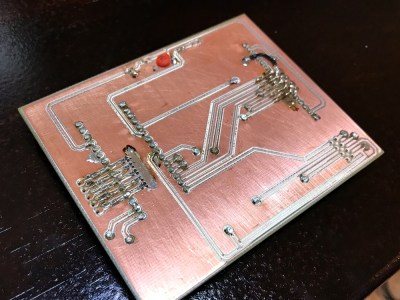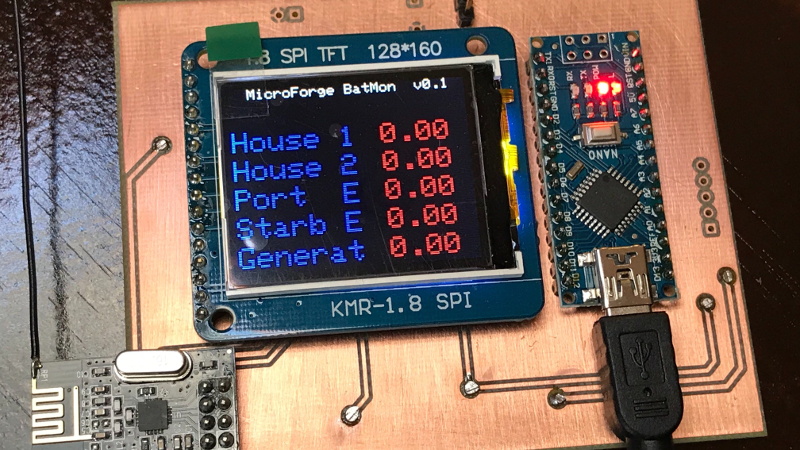While those of us stuck sailing desks might not be able to truly appreciate the problem, [Timo Birnschein] was tired of finding that some of the batteries aboard his boat had gone flat. He wanted some way to check the voltage on all of the the batteries in the system simultaneously and display the information in a central location, and not liking anything on the commercial market he decided to build it himself.
 Even for those who don’t hear the call of the sea, this is a potentially useful project. Any system that has multiple batteries could benefit from a central monitor that can show you voltages at a glance, but [Timo] is actually going one better than that. With the addition of a nRF24 module, the battery monitor will also be able to wireless transmit the status of the batteries to…something. He actually hasn’t implemented that feature yet, but some way of getting the data into the computer so it can be graphed over time seems like a natural application.
Even for those who don’t hear the call of the sea, this is a potentially useful project. Any system that has multiple batteries could benefit from a central monitor that can show you voltages at a glance, but [Timo] is actually going one better than that. With the addition of a nRF24 module, the battery monitor will also be able to wireless transmit the status of the batteries to…something. He actually hasn’t implemented that feature yet, but some way of getting the data into the computer so it can be graphed over time seems like a natural application.
The bill of materials is pretty short on this one. Beyond the aforementioned nRF24 module, the current version of the monitor features an Arduino Nano clone, a 128×160 SPI TFT display, and a handful of passives.
Knowing that a perfboard wouldn’t last long on the high seas, [Timo] even routed his own PCB for this project. We suspect there’s some kind of watertight enclosure in this board’s future, but it looks like things are still in the early phases. It will be interesting to follow along with this one and see how it eventually gets integrated in to the boat’s electrical system.
If you’re looking for a way to keep an eye on the voltages aboard your land ship, this battery monitor disguised as an automotive relay is still the high-water mark in our book.

















Favourite way of checking a large lead acid battery for “has some punch left” is a spanner across the terminals. Spark means yes.
Perhaps to automate this, some robot arms could be programmed to undertake the periodic spanner based tests. Open CL could be used to look for sparks and judge state of charge from colour, brightness and distance bits of molten metal fly.
OK, maybe Timo’s method is more sensible, safe, achievable, affordable and all other good aspects. But I like sparks!
It’s not, voltage has never been a good way to figure out the SOC (state of charge).
Ones need proper battery monitor with shunt, coulombmeter from China changed everything about knowing the percentage left in the battery in my minivan and it cost nothing compared to the battery (and the potential damage discharging the lead acid or overcharging the Lifepo4)
A single reading isn’t very useful but voltage over time is.
Is it sagging under load? Did it drop heavily after use? Has the voltage seemingly recovered?
All will give great insight into the battery’s heath not just soc
Thank you! This is summing up why I did it this way!
…and welding, apparently!
This would be great for knowing when to replace individual Prius cells.
exactly
voltage monitor is very old technology,
replaced today by state of charge, percentage left in the battery, voltage and current, power consumed live data
QV smart gauge & Peukert curve
While I agree that voltage is not a good way to determine state of charge it IS a simple way to determine the battery is functional.
A quick voltage measurement will tell you the charger is still working and the battery hasn’t failed since you last checked it.
The only way to really know the state of charge is to discharge the battery to a known flat state log the voltage and current till it’s flat and calculate the energy consumed. Anything else’s is only a best guess and some methods are better than others but you don’t get much simpler than a voltage measurement.
Which incidentally is the name of the project
”A Simple 5 Ch Boat Battery Monitor”
The emphasis I suspect is on the “simple”
But I’m sure someone could have done it with a 555…
“But I’m sure someone could have done it with a 555…”
Not here…an RPi 4 with overclocking, 4 GB of RAM, PoE, and a massive heatsink would be used, along with the complaint that 8 GB and/or a RPi 5 is really what’s needed.
Yes voltage is a quick and dirty way to check batteries, has issues with that method which is why when the mechanic checks checks your car battery for instance they put a load on it. The checker I have at home for my rechargeable batteries also puts a bit of a load of some sort and spits out a percentage of charge.
I would think not too difficult to add a small automated load test to the measurements, extra wires and handling some higher amperage loads, but should be doable,
Some fancy systems now measure power in and power out of a battery to estimate the charge remaining, have a couple of friends that put such a system on their sailboats when they went cruising.
What a fun coincidence. I just published my own version of this sort of thing. I live and die by the off-grid house batteries, and the previous solution was imperfect and too complex. While not documented to Hackaday standards, I’d guess the code I posted might be helpful to someone.
http://www.coultersmithing.com/forums/viewtopic.php?f=32&p=6814
This is part of my own lan of things. The old one had its own raspi and database, but now I’m consolidating that function into a pi that lives indoors, instead of a battery shed.
Nice! Thanks for posting. You’re using my weapon of choice – ESP8266.
Yes, to the critiques!
I needed a way to determine if the charger is working. The issue was that I have three batteries combined to a single charger using a “battery combiner”. This seems to be a typical configuration on boats with multiple batteries for multiple separate purposes.
The issue is, this combiner had several cold solder joints and stopped functioning. I didn’t notice that my batts are not being maintained until I stranded for ankor at some island with a very bad sea state and high winds. Suffice to say, that wasn’t a very enjoyable experience.
This monitor helps me see the charging voltage and the current voltage when they are not being maintained. That’s sufficient to determine the batteries are safe to use for a tour.
I just managed my expectations and designed for a specific use case.
My sailboat has dual batteries and the panel has a simple analog meter with a three position toggle switch – center off – simple like yours – does what I need
Yes, I do have a similar setup in my electrical cabinet but it’s not where I need it and the response time of the analogue gauge is very sluggish. I wanted something that I can log over time and see what’s going on during starting the engines without crawling into the engine room.
Anybody seriously concerned with battery capability will be well versed in Peukert curve
https://en.m.wikipedia.org/wiki/Peukert's_law
This is a first cut. Thanks for the tip! Maybe there will be a second version in the future. Who knows!
Looks very similar to my project: https://hackaday.io/project/167291-rv-battery-monitor
Why would a home-routed PCB with thin traces and no soldermask be more resistant to the sea than a perfboard? I get the concern but I would have put a nice thick coat of enamel over it after soldering and still used nice wide traces just in case a bit of salt water got to one. It would take more of a problem for it to corrode the whole way through. Or.. as a one off you could always spray enamel over the back of a perfboard once all the soldering is complete.
The device will be mounted indoors on a heated and ventilated motor boat. Not saying this will last forever and coating is definitely a good idea!
This is certainly more resilient to the breadboard I made for testing, so I’m not concerned about vibration, yet.
Nice project, Timo!
This hits pretty close to home with me because we have a little sailboat, I’m a nerd, and about 4 years ago I started working on a boat monitoring system which I hoped would have commercial potential. My “insight” was that most boats spend 90+% of the time moored/docked/stored somewhere with wifi (marinas, clubs, cottage, home). So a monitoring system that periodically connected to wifi and transmitted status would be an economical way to remotely monitor your boat. The ESP8266 was my chosen platform.
Besides inputs to monitor things like bilge pump, motion detector, smoke detector, etc, I used the ESP8266’s A/D converter to monitor batteries. For remote monitoring, battery voltage tells you 99% of what you need to know remotely: whether a cell has shorted, whether the batteries are close to fully charged, whether the charger is working. Basically – if you’re a weekend warrior, you want to know you won’t be coming down to the boat to find dead batteries.
About 2 years ago, I discovered that another developer had the same idea and was well ahead of me, and that they’d done a great job on a commercial-grade effort(https://floathub.com/), so I reluctantly gave up my own efforts, but I still made something to play with and to meet our own needs.
So to Timo – if you have wifi where you keep your boat, add an ESP8266 to the system.